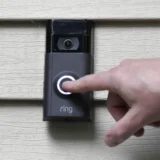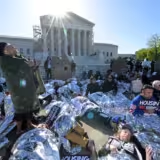WASHINGTON INFORMER: D.C. Mayor Muriel E. Bowser has been reelected to serve a third term. She’s the first to match the record three terms “Mayor for Life” Marion Barry won when he led the District.
Since first taking office, Bowser’s commitment to ensuring Black homeowners that they can stay in the city has not been without stumbling blocks. Over the past ten years, the District has seen a net loss of Black homeowners. And while Bowser wasn’t elected until 2015, just between 2018 and 2020 alone the city lost 3,045 Black homeowners. This is despite DC’s Black homeownership rates that have historically been among the highest in the nation.
To come up with ideas to raise the number of Black residents who own homes in the District, Bowser gathered a group of neighborhood advocates and municipal officials last June. Calling the group the Black Homeownership Strike Force, they were tasked with developing a long-term plan to produce 20,000 new Black homeowners in the District by 2030.
At-Large Councilmember Anita Bonds, who also won reelection to a term beginning in 2023, was part of the strike force. She explained, “The mayor wanted us to look into the issues surrounding home ownership, and wanted us to explore ideas about how to keep Black residents in the homes they own. We came up with the ideas that were released in the strike force plan.”
According to the 28-page findings of the Strike Force, racial covenants and inequities in mortgage financing, through strategies like redlining, have created obstacles for Black homeowners and fostered homeownership inequality in the District. According to the report, the proportion of Black city residents has decreased from almost 70% in 1970 to less than 50% during the last ten years. The report’s data from the American Community Survey showed a net loss of 5,000 Black homeowners between 2010 and 2020.
Members of the strike force say that meeting this increased ownership objective will help the city overcome long-standing, discriminatory housing laws that were formerly widespread in the U.S. and are still responsible for today’s unequal homeownership rates. Approximately 34% of Black D.C. residents own their houses, down from 46% in 2005, according to statistics from the American Community Survey used in the analysis.
Between 1990 and 2019, the percentage of White homeowners in the city climbed from 47% to 49%.
Bonds said that the task force made certain to strike the proper balance between being feasible and aspirational, “We had extensive research and discussions with the public. Then we decided that 20,000 homeowners could be possible. But it requires some help from the city.”
Members of the strike force recommended that Bowser increase resources to help residents transfer their homes to their children and heirs, offer technical assistance to Black homeowners who must renovate their homes, develop a program specifically for Black homeowners at risk of foreclosure, and find ways to speed up zoning and permitting for affordable housing projects in order to reverse the trends that lead to the decrease in the District’s Black homeownership rates.
Another recommendation suggests the city use the $10 million that Bowser allocated for the strike force to establish a public-private fund that would provide Black homebuyers with a range of affordable housing options.
Of course, there are issues with home affordability and the larger context of institutional racism to take into account. But some of the most driving causes that have proven to make homeownership more difficult for Black buyers are longstanding and unfortunately, lingering.
The analysis found that between 2005 and 2015, 49% increase in median homeowners association dues and condominium fees, disproportionately burden Black people. Even more concerning, the analysis finds that home appraisal values have skyrocketed in the city’s majority-Black neighborhoods, which may be related to a historical trend in which property assessors overvalued Black-owned properties which is the primary factor in causing property tax bills to skyrocket.
When the report was released in early October of this year, Bowser said at a media event about the findings that the recommendations of the team would be a challenge for her administration to decide whether the suggestions are “exhaustive enough.” Before including the proposals in the budget she submits to the D.C. Council next year, Bowser said she will also ascertain the recommendations’ cost and legality.
Their ideas, she believes, will likely build on some of the city’s other programs aimed at keeping residents in the city, most notably the Home Purchase Assistance Program, which was expanded on Oct. 1 to offer first-time home buyers a benefit of up to $202,000, up from $80,000. Another District initiative offers interest-free loans and matching funds to city government employees for down payments and closing costs on their first home purchase. However, Bowser stated that she was particularly interested in exploring more ways that the city can assist potential homeowners in competing for properties with the region’s many wealthy investors.
Bowser’s plan will likely benefit from a proposed $26M in the 2023 budget to help low-income first-time homebuyers with down payment and closing cost assistance. Since she’ll have a third term in which to work, this is a space that aspiring homeowners should fully expect to see more initiatives to support their goal.
This article was written by the Washington Informer, read more stories like this here.










